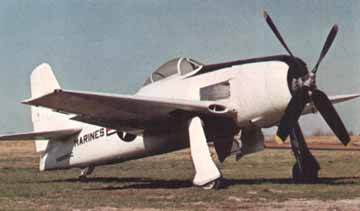Junior worked for the telephone company for years, crop dusting in the early mornings and late evenings, fooling around with airplanes every spare minute.He bought his first fighter, a P-40, for $300 in the early 1950s, and since then has owned just about everything the military ever operated, including a rare A-20 Havoc light bomber and a J2F-6 Grumman/Columbia Duck biplane amphibian. Eventually, he left the phone company, set up his own airport and started dusting and instructing full time.
It's a shock to come over the hill west of Paris, Texas, and suddenly come upon Burchinal's collection huddled at the side of the road. Pull over to the edge and you can walk between the rows of aircraft. A transient UC-78 cowers under the wing of the brightly polished B-25 with Capt. Ted Lawson's famous Ruptured Duck emblem from the Doolittle Tokyo raid painted on the nose. Behind the 25 is a silver B-26 (A-26 to war horses), the Douglas Invader that is still serving airforces the world over.
On a weekend there are always visitors; standing by the FG-1 D (F4U-1D) Corsair, I hear a man tell his son about Saipan and the Marianas and the son says "Daddy, did you really fly?" The look in the man's eye answers as he runs a hand across the bent leading edge.
 |
|
| His Bearcat was the old Ms. Smirnof flown by Mira Slovak at the very first Reno races. |
Burchinal's latest acquisition, a P-38L, appears almost out of place
with its tricycle gear, and a Durantelike camera nose. The Bearcat is
twice famous-as a fighter and as a racer. This particular F8F-2 is the
one Mira Slovak rode to victory in the 1964 Reno pylon party, then number
80 and called Miss Smirnov. The Bearcat dwarfs the little FM-2 (F4F)
Goodyear-built Wildcat, sitting there crosslegged, its belly barely clearing
the grass and its barndoor wing putting out lots of shade.
It's hard to believe just a little over a decade separates the Grumman
Wildcat and the F9F-2 Grumman Panther sitting next to it. They are worlds
apart, and the F-86D accentuates the difference between yesterday and
the day-before-yesterday.
The jets don't fly, but the silver North
American SNJ-5 Texan more than makes up for it. It's most often parked
at the gas pump because somebody's always riding it hard. The SNJ is the
most important step up in the warbird game, and it leads to the acknowledged
king of the stable, the Mustang.
Wearing invasion stripes and the colors of Col. J.J. Christiansen, 479th
fighter group, 435th fighter squadron, 8th Air Force (he was shot down
over France in 1944), the P-51D sits there as a constant challenge
saying, "Come on. Fly me. Here's your chance." And that's
what this collection represents: a chance. A chance for pilots like
me, who were too young, in the wrong service, or just want another
go at it. Here's a chance to fly fighters without actually going through
all the hassle of buying one and with the added benefit of a careful,
professional checkout.
Burchinal's reason for operating this type of equipment in a flight school
is three-fold: First of all, it gives everybody with a little money
the chance to play World War II under supervision. Secondly, and most
important, it offers a complete and thorough checkout service for the
guy who's either already bought, or is contemplating buying, a warbird.
The last reason for a preacher/ crop-duster to be playing ace is that he feels these old airplanes ought to be kept flying and in front of the public as symbols of some of America's greatest men and finest moments. He makes himself and his air force available to any worthwhile show that can cover his expenses. He's fiercely patriotic and regards each of his airplanes as a shrine to the men who flew it.
As might be expected, the FAA originally was stunned at the thought of somebody turning students loose in 2,000-hp machines, and they investigated Burchinal closely. At first, there was some problem about the wording of the regulations pertaining to aircraft in the Limited and Restricted categories, but the home office in Washington came through with a definition that said it wasn't illegal to give instruction; it was just against the FARs to carry passengers commercially, and a student isn't a passenger (how's that for nit-picking?).
Burchinal says he would have been shut down a long time ago if the Dallas FAA GADO weren't under the guidance of a Mr. P. Pring and Mr. Turner. He can relate countless examples of both private individuals and FAA personnel trying to shut him down, but each time the top honchos would arrive like the cavalry in the nick of time.
The FAA has apparently realized that Burchinal offers a valuable service to the aviation community by giving proper training and checkouts to warbird nuts. As long as there are fighter aircraft flying, people will want to move up to them, and right now Burchinal is about the only man they can run to and be assured of getting first-rate instruction.
Also, the FAA men have stood over Burchinal like a bunch of hungry hawks all the years he's been operating his school, and during his many Mustang air show aerobatic performances, and they've found that he operates safely and encourages his students to do the same. Also, he's been operating Mustangs for a longer span than World War II lasted, so they figure he must have learned something.
GO TO PAGE THREE
For lots more pilot reports like this one go to PILOT REPORTS.